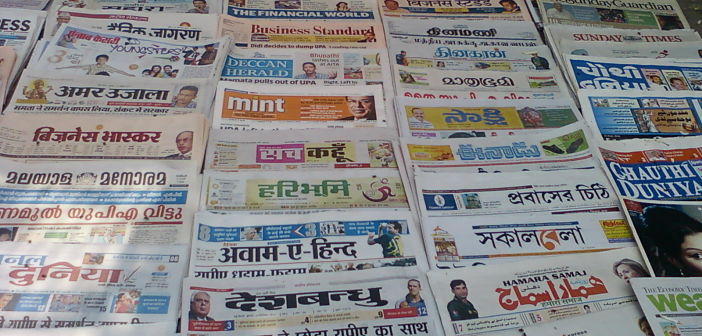According to the Statistical Handbook on Media & Entertainment Industry 2024–25, the number of registered periodicals, All India Radio stations, and private FM stations has all increased over the last many years. However, the share of the industry in the number of recognised startups and FDI has been shrinking.
In the first part of this two-part series on Media and Entertainment (M&E) Industry, we looked at the overview of the sector, broadly covering the present and future of the industry, its contribution to GVA and changes happening within the M&E industry due to the advent of digital media.
In this final and last part, we will take a closer look at individual segments within the industry and examine how each of them is performing.
Print still thrives: Registered Periodicals cross 1.5 Lakh mark in 2023-24
Periodicals such as newspapers and magazines are publications that come out regularly or occasionally and have long played an important role in sharing knowledge, even in the digital age.
In India, the Press & Registration of Periodicals Act (PRP Act), 2023 defines a periodical as any regularly published material that shares public news or commentary, excluding books and scientific, technical, or academic journals. These exclusions mark a shift from the older Press and Registration of Books Act (PRB Act), 1867, which required even such journals to be registered.
Recent data shows significant growth in registered periodicals in India. For the first time, the total crossed 1.5 lakh in 2023–24 and reached 1.54 lakh in 2024–25. This is a nearly 90% increase from 82,222 in 2010–11 and almost triple the number from 2002–03. About 60% of these are either weekly or monthly publications.
Looking at language-wise data, Hindi leads with over 60,000 periodicals (40%), followed by English (13%) and Marathi (7.5%). Among states, Uttar Pradesh has the highest number of registered periodicals at 22,741, followed by Maharashtra (21,522), Delhi (16,484), and Madhya Pradesh (15,463).
Radio still growing strong despite changing media landscape
Radio is one of the oldest ways people access news and entertainment. In a country like India, with multiple different languages and cultures, radio has stayed popular for many years. Even though podcasts and music apps are now common, radio is still an important part of daily life.
One big reason is that the radio is easy to access. People can listen to regular radio, in their cars, or on mobile apps. It’s also great for sharing local news, weather, traffic updates, and public messages. This local connection is something many digital platforms can’t offer.
Radio in India has grown significantly over the years. The number of All India Radio (AIR) stations went up from 198 in 2000 to 591 in 2025. Arunachal Pradesh has the most with 39 stations, followed by Madhya Pradesh and Rajasthan (38 each), and Maharashtra and Uttar Pradesh (37 each).
Community Radio started with just 1 station in 2004, but by March 2025, there were 531 stations running across the country. Private FM Radio has also grown—from just 4 stations in 2001 to 388 by 2025.
Despite the new tech, radio still has its relevance and plays a big role in keeping people connected and informed.
M&E Startup numbers rising, yet share of all startups remains low
India’s Media and Entertainment (M&E) sector holds strong potential for innovation, mainly because of the wide variety of content being created. According to the Statistical Handbook on M&E 2024–25, a total of 2,458 startups in this sector had been recognised by the Department for Promotion of Industry and Internal Trade (DPIIT) as of 31 March 2025.
These startups make up 1.46% of all DPIIT-recognised startups in the country. Although the number of M&E startups has grown over time, their share in the overall startup ecosystem has stayed below 2%. In fact, their proportion in 2024 was lower than what it was in 2020, showing that while more startups are emerging, their pace of growth hasn’t matched the broader startup landscape.
Still, the total number of M&E startups has largely increased over the years. DPIIT recognised 320 new ones in 2021, 357 in 2022, and 443 in 2023. The numbers dipped slightly in 2024 with 268 recognitions and further to 120 in the early part of 2025, but the overall direction remains upward.
Looking closer at the 2,458 recognised startups, entertainment is the largest category with 693 startups, making up 28% of the total. Digital media follows closely, with around 24% of the startups. Within digital media, news leads with 205 startups, followed by video (185), publishing (172), and blogging (30).
FDI Equity inflows to I&B, and Print and Media below 2%
In recent years, India has become a popular destination for foreign investment. To boost the economy and attract more global capital, the FDI (Foreign Direct Investment) policies were made more flexible. Today, over 90% of FDI comes in through the automatic route, meaning investors don’t need prior government approval in most sectors.
The cumulative FDI equity Inflow between April 2000 to December 2024 stood at ₹ 46.87 Lakh Crore (USD 719.53 billion). Out of these, Information & Broadcasting (including Print Media) accounted for ₹ 74,369 Crore (USD 11.6 billion), accounting for nearly 1.6%. Services sector and computer software and hardware accounted for almost 30% of the FDI Equity inflows during the same period.
The data since 2012 show that FDI equity inflows into the Information & Broadcasting sector, including Print Media, peaked at ₹11,501 crore in 2016. This surge followed the easing of FDI rules that year, which increased the limit to 49% for news-related TV channels and allowed 100% FDI in entertainment channels. The sector received ₹5408 Crore in 2024, dropping from ₹7,211 crore in 2023. It’s still well above the pandemic-era lows seen in 2020 and 2021, showing steady foreign interest in the sector.
The segmental distribution of FDI Equity inflows shows that radio broadcasting drove the FDI boost in 2024, pulling in ₹3,853 crore—its highest FDI inflow since 2016. The film and advertising segment also performed well, attracting ₹1,555 crore. However, electronic and print media have seen no new foreign investments since 2019.
Despite healthy inflows, the sector’s share in total FDI has gone down, from 2.11% in 2023 to 1.22% in 2024, after a peak of 3.69% in 2016.



